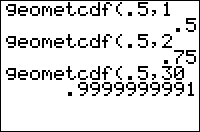TI-BASIC:Geometcdf
Command Summary
Calculates the cumulative geometric probability for a single value
Command Syntax
geometcdf(probability, trials)
Menu Location
Press:
- 2ND DISTR to access the distribution menu
- ALPHA E to select geometcdf(, or use arrows.
Press ALPHA F instead of ALPHA E on a TI-84+/SE with OS 2.30 or higher.
TI-83/84/+/SE
2 bytes
This command is used to calculate cumulative geometric probability. In plainer language, it solves a specific type of often-encountered probability problem, that occurs under the following conditions:
- A specific event has only two outcomes, which we will call "success" and "failure"
- The event is going to keep happening until a success occurs
- Success or failure is determined randomly with the same probability of success each time the event occurs
- We're interested in the probability that it takes at most a specific amount of trials to get a success.
For example, consider a basketball player that always makes a shot with 1/4 probability. He will keep throwing the ball until he makes a shot. What is the probability that it takes him no more than 4 shots?
- The event here is throwing the ball. A "success", obviously, is making the shot, and a "failure" is missing.
- The event is going to happen until he makes the shot: a success.
- The probability of a success - making a shot - is 1/4
- We're interested in the probability that it takes at most 4 trials to get a success
The syntax here is geometcdf(probability, trials). In this case:
:geometcdf(1/4,4
This will give about .684 when you run it, so there's a .684 probability that he'll make a shot within 4 throws.
Note the relationship between Geometpdf( and geometcdf(. Since geometpdf( is the probability it will take exactly N trials, we can write that geometcdf(1/4,4) = geometpdf(1/4,1) + geometpdf(1/4,2) + geometpdf(1/4,3) + geometpdf(1/4,4).
Formulas
Going off of the relationship between geometpdf( and geometcdf(, we can write a formula for geometcdf( in terms of geometpdf(:
Math \operatorname{geometcdf}(p,n) = \sum_{i=1}^{n} \operatorname{geometpdf}(p,i) = \sum_{i=1}^{n} p\,(1-p)^{i-1} /math
(If you're unfamiliar with sigma notation, <math>\sum_{i=1}^{n}</math> just means "add up the following for all values of i from 1 to n")
However, we can take a shortcut to arrive at a much simpler expression for geometcdf(. Consider the opposite probability to the one we're interested in, the probability that it will not take "at most N trials", that is, the probability that it will take more than N trials. This means that the first N trials are failures. So geometcdf(P,N) = (1 - "probabiity that the first N trials are failures"), or:
Math \operatorname{geometcdf}(p,n) = 1-(1-p)^n /math
